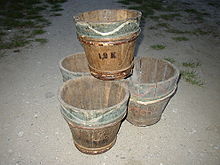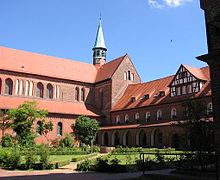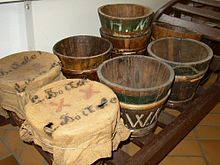- Tiene
-
Tiene, sometimes also called Tine or Obsttiene, was a special container for transporting wine and fruit. These were used until shortly after the First World War, mostly in the Brandenburg city of Werder in northern Germany. Normally the wooden tubs were carried on people's backs to small boats and shipped on the Havel River to market stalls in Berlin.
Contents
History
The fruit growing-area around the river island city of Werder has a long tradition, back to the fruit fields of the Cistercian monks in the Lehnin Abbey, one of the oldest cloisters in Brandenberg, established in 1180. The abbey lands produced large amounts of grapes and other fruits which were processed and transported to Berlin.
The term Tiene comes from the wooden vats in which the grapes were pressed for processing into wine, used originally in the 16th and 17th centuries. In the 19th century, fruit growers transferred the term onto the small wooden tubs in which they transported their fruit.
Capacity and construction
A Tiene holds approximately 7 liters, or 3.5 to 4 kg mass, depending on the kind of fruit. The oak tubs weigh 1.8 kg, while tubs made from spruce weigh 1.6 kg. The conical Tienen were prepared for shipping by covering the top with linen cloth. By circa 1900 more than 200,000 Tienen were in use in the Werder region and their production was a significant craft industry in the town.
Three coopers worked on the island and it is to be supposed that the cooper's trade began in the 18th century in Werder. Before the Tienen were sold to the fruit farmers, the coopers had to calibrate them. The Tienen were dried and then weighed and the dead weight was branded on the outside. A new Tiene for cherries with a capacity of 7 to 9 pounds cost sixty Pfennig in 1908. A Tiene for raspberries weighed 50 to 60 pounds.
Werder pioneered these transport containers and when it introduced the Chip basket (made from wooden chips) in 1910, the Tiene quickly lost their former importance.
Significance of the industry
Theodor Fontane remembers walking along the Brandenburg March on his way to school in Berlin. His path led him through crowds of the Werderschen, his name for the inhabitants of Werder, every morning between Friedrich's bridge and the Herkules-bridge at its original location on Burg-street:
Sometimes it probably also happened that we saw the late » second meeting « of the Werderschen, from the Unterbaum, rowing big boats close with Tienen full of fruit, while on the oar benches twenty women sat and moved their oars and the heads with their panniers hats moving with equal energy. [...] The air swam in a refreshing smell, and the domed construction of the inverted Tienen piled up about one another. This interested us more than the comfortable construction of Castle Monbijou and I am sad to say, , also more interesting than the column wood of the New Museum of Schinkel.
References
External links
- Tiene. From the German-language Wikipedia. Retrieved February 6, 2008, and containing the internal reference:
Literature
- Theodor Fontane: Wanderungen durch die Mark Brandenburg. Part 3-rd Havel's land. (1-st edition in 1873.) citation after the issue: Nymphenburger Verlagshandlung, Munich in 1971, Frankfurt am Main, Berlin. Page 418. ISBN 3-485-00293-3. Because of many different issues the tip: Chapter Die Werderschen, 1-st segment. (German)
- Dr. H.-Joachim Koch: Blütenstadt Werder/Havel Heimatgeschichtliche Beiträge 1984 Page 18-21 no ISBN (German)
Coordinates: 52°22′09.24″N 12°55′57.00″E / 52.3692333°N 12.9325°E
Categories:- Containers
- Towns in Brandenburg
Wikimedia Foundation. 2010.



